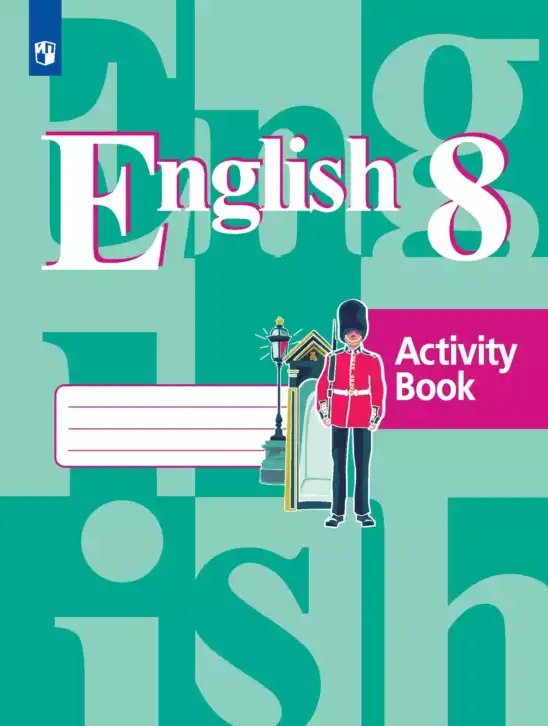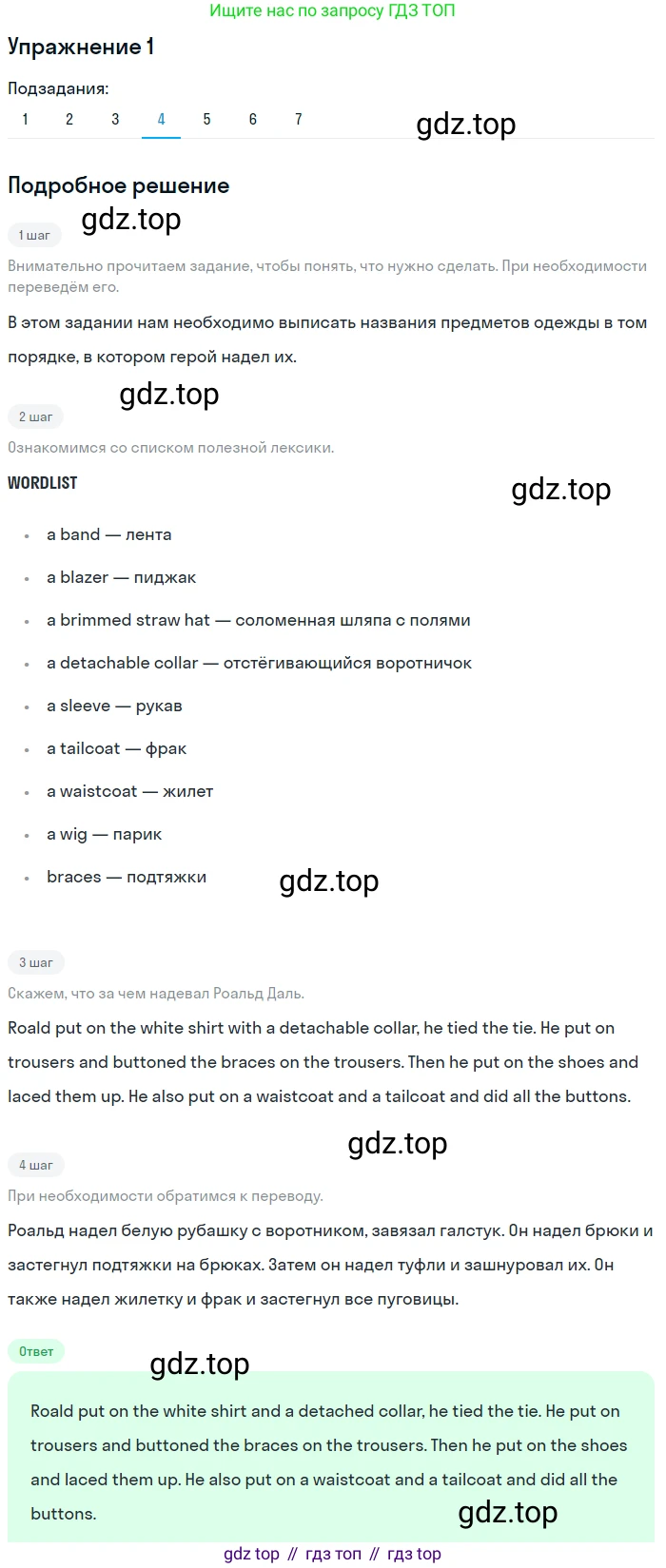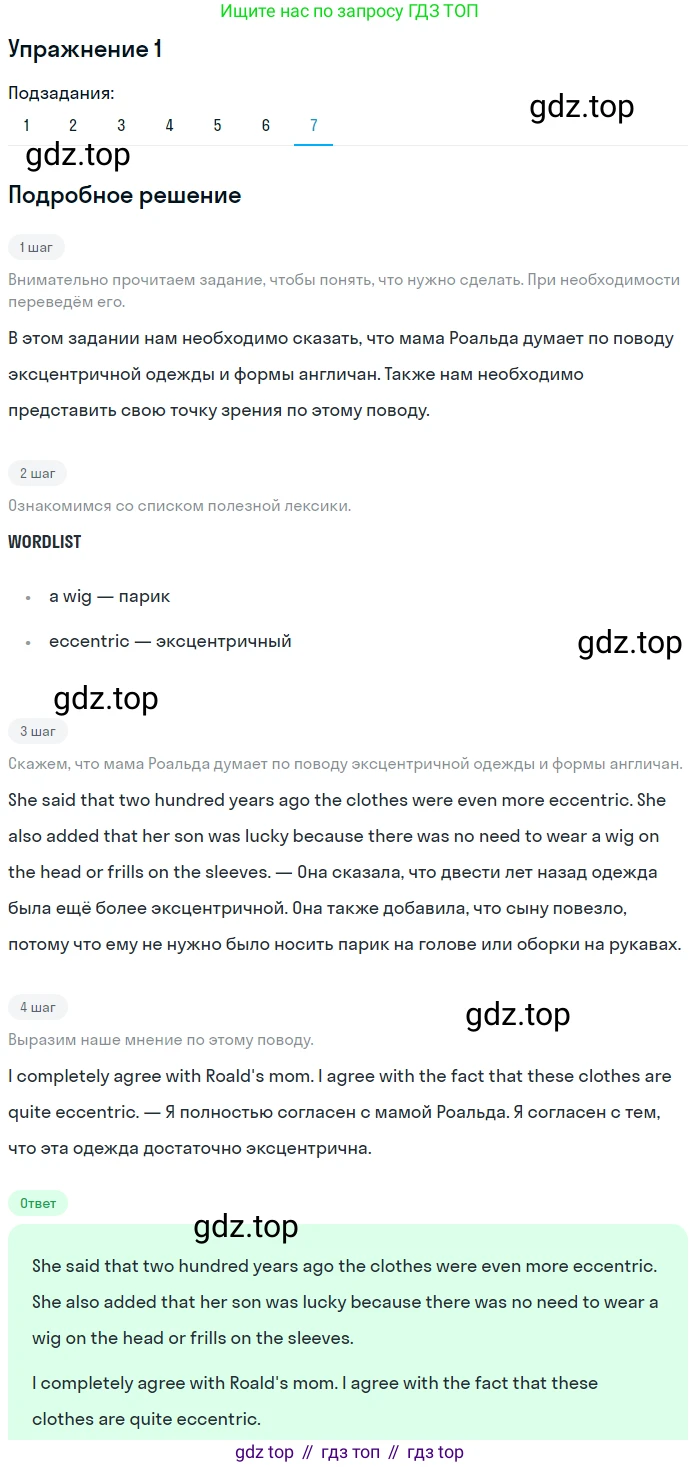Номер 1, страница 166 - гдз по английскому языку 8 класс учебник Кузовлев, Лапа

Авторы: Кузовлев В. П., Лапа Н. М., Перегудова Э. Ш., Костина И. П., Кузнецова Е. В., Дуванова О. В., Кобец Ю. Н.
Тип: Student's book (Учебник)
Издательство: Просвещение
Год издания: 2014 - 2025
Цвет обложки: зелёный, бирюзовый с солдатом
ISBN: 978-5-09-036048-7
Рекомендовано Министерством образования и науки Российской Федерации
Популярные ГДЗ в 8 классе
Unit 6. Changing times, changing styles. Lesson 5. «Nobody wears things like that!» - номер 1, страница 166.
№1 (с. 166)
Условие. №1 (с. 166)
скриншот условия



You are going to read a short extract from the book Boy by Roald Dahl. The book is about the author's childhood and school years.
1) Look at the picture, read the captions and say what occasion Roald Dahl got dressed for. (anticipating)
I still feel an ass.1
Two hundred years ago their clothes were even more eccentric than they are today.
I feel like an under-taker's apprentice in a funeral parlour.2
Nobody's going to pay any attention to you!
I'll look like an idiot.
He can't go out in those.
It was the most ridicu-lous piece of clothing I had ever seen.
Nobody wears things like that.
He'll be arrested by the police.
2) Look at the pictures and match the Russian words with the pictures and cap-tions. (guessing meaning)
a detachable [drɪ'tætʃəbl] collar
a wig
a straw hat with a blue and black band around it
trousers with thin grey pin-striped lines
a tailcoat
a blazer
a waistcoat with two little pockets
frills on the sleeves
braces
соломенная шляпа с чёрно-синей лентой вокруг • парик
жилет с двумя маленькими карманами • съёмный воротник
брюки из ткани в тонкую светло-серую полоску • блейзер (пиджак)
3) Read the story, look at the picture and say which pieces of clothing were parts of Roald Dahl's school uniform and which were not. (reading for detail)
I was exactly thirteen in September 1929 when the time came for me to go to school to Repton.* I had first of all to get dressed. I had been to London with my mother the week before to buy the school clothes, and I remember how shocked I was when I saw the clothes I was expected to wear.
And now this amazing fancy dress was there on my bed. "Put it on," my moth-er said. "Hurry up or you'll miss the train." "I'll look like an idiot," I said. My mother went out of the room and left me to it.
I began to dress myself. First there was a white shirt with a detachable white collar. Around the white collar, I tied a black tie. Then came the trousers and the braces. The trousers were black with thin grey pin-striped lines. I buttoned the braces on to the trousers, six buttons in all. Then I put on the trousers with the braces and a new pair of black shoes.
Now for the waistcoat. This was also black and it had twelve buttons and two little waistcoat pockets. I put it on and did up the buttons. All this was bad enough for a boy who had never before worn anything more elaborate than a pair
| WORD BUILDING | |
|---|---|
| a button – to button – ? | a tie – to tie – ? |
| (пуговица) | GS p. 203 |
Unit 6
of shorts and a blazer. Then I put on the jacket. The jacket wasn't actually a jacket, it was a sort of a tailcoat. No doubt, it was the most ridiculous piece of clothing I had ever seen. In the front there was one button and from this but-ton downwards, the lines of the coat separated, forming a pair of "tails". I put the thing on and did up the front buttons. Feeling like an undertaker's appren-tice in a funeral parlour, I walked downstairs. My sisters fell all over the room laughing when I appeared. "He can't go out in those!" they cried. "He'll be arrest-ed by the police!" my mother said, giving me a straw hat with a blue and black band around it. I put it on and did my best1 to look dig-nified.2 "Nobody's going to pay any attention to you," my mother said as we walked through Bexley High Street. And to my surprise, nobody was.
"I have learnt one thing about England," my mother went on. "It is a country where men love to wear uniforms and eccentric clothes. Two hundred years ago their clothes were even more eccentric than they are today. You can consider yourself lucky, you don't have to wear a wig on your head and frills on your sleeves." "I still feel an ass," I said.
"Everyone who looks at you," my mother said, "knows that you are going away to a Public School. All English public schools have their own different crazy uni-forms. People will be thinking how lucky you are to be going to one of those famous places."
4) What order did Roald get dressed in? Write out the names of the pieces of clothing in the order they were put on. (reading for specific information/making notes)
5) Learning to translate. Write out which of the following statements are true and which are false according to the text? Translate the statements. (understand-ing grammar structures with the infinitive of purpose) (GS p. 191)
I did my best to look dignified.
Я старался изо всех сил, чтобы выглядеть достойно.
1. Roald and his mother went to London to buy the school clothes.
2. Roald's mother went out of the room to give her son an opportunity to get dressed.
3. Roald put a shirt and took a black tie to tie it around the collar.
4. Then he took the waistcoat to put it on over the shirt.
5. He put on the jacket to show how amazing his new school uniform was.
6. In his new outfit Roald walked downstairs to make his sisters laugh.
7. Downstairs mother waited for Roald to give him a new straw hat.
8. Roald walked slowly through Bexley High Street to show everyone that he was going to one of the most famous English public schools.
6) Find in the story the words which describe "the school clothes". What emotions do the words suggest?
7) How did Roald's mother try to comfort her son? Was Roald's mother English by origin or not? Prove your opinion from the text.
Решение. №1 (с. 166)







Решение 2. №1 (с. 166)
1. Посмотрите на картинку, прочитайте подписи и скажите, по какому случаю одевался Роальд Даль.
Ответ:
Roald Dahl was getting dressed to go to his new public school, Repton.
Роальд Даль одевался, чтобы пойти в свою новую частную школу, Рептон.
2. Посмотрите на картинки и сопоставьте русские слова с картинками и подписями.
Ответ:
| a detachable collar | съёмный воротник |
| a straw hat with a blue and black band around it | соломенная шляпа с чёрно-синей лентой вокруг |
| a wig | парик |
| trousers with thin grey pin-striped lines | брюки из ткани в тонкую светло-серую полоску |
| a tailcoat | фрак |
| a waistcoat with two little pockets | жилет с двумя маленькими карманами |
| braces | подтяжки |
| a blazer | блейзер (пиджак) |
| frills on the sleeves | оборки на рукавах |
3. Прочитайте рассказ, снова посмотрите на картинки и скажите, какие предметы одежды были частью школьной формы Роальда Даля, а какие — нет.
Ответ:
Part of the uniform: a white shirt with a detachable collar, a black tie, black trousers with thin grey pin-striped lines, braces, black shoes, a black waistcoat, a tailcoat, a straw hat.
Not part of the uniform: a wig, frills on the sleeves, a blazer.
Частью формы были: белая рубашка со съемным воротником, черный галстук, черные брюки в тонкую серую полоску, подтяжки, черные туфли, черный жилет, фрак, соломенная шляпа.
Не были частью формы: парик, оборки на рукавах, блейзер.
4. В каком порядке одевался Роальд? Выпишите названия предметов одежды в том порядке, в котором он их надевал.
Ответ:
1. A white shirt with a detachable white collar.
2. A black tie.
3. Trousers with braces.
4. A pair of black shoes.
5. A waistcoat.
6. A jacket (a tailcoat).
7. A straw hat.
1. Белая рубашка со съёмным белым воротником.
2. Чёрный галстук.
3. Брюки с подтяжками.
4. Пара чёрных туфель.
5. Жилет.
6. Пиджак (фрак).
7. Соломенная шляпа.
5. Учимся переводить. Какие из следующих утверждений верны, а какие — ложны согласно тексту? Переведите утверждения.
Ответ:
1. True. (Roald and his mother went to London to buy the school clothes.)
Верно. (Роальд и его мама поехали в Лондон, чтобы купить школьную одежду.)
2. True. (Roald's mother went out of the room to give her son an opportunity to get dressed.)
Верно. (Мама Роальда вышла из комнаты, чтобы дать сыну возможность одеться.)
3. True. (Roald put a shirt and took a black tie to tie it around the collar.)
Верно. (Роальд надел рубашку и взял чёрный галстук, чтобы повязать его вокруг воротника.)
4. False. He put on the trousers and shoes before the waistcoat. (Then he took the waistcoat to put it on over the shirt.)
Неверно. Он надел брюки и туфли перед жилетом. (Затем он взял жилет, чтобы надеть его поверх рубашки.)
5. False. He thought the uniform was ridiculous. (He put on the jacket to show how amazing his new school uniform was.)
Неверно. Он считал форму нелепой. (Он надел пиджак, чтобы показать, какой потрясающей была его новая школьная форма.)
6. False. He walked downstairs and his sisters laughed at him; it was not his intention to make them laugh. (In his new outfit Roald walked downstairs to make his sisters laugh.)
Неверно. Он спустился вниз, и сёстры рассмеялись, глядя на него; у него не было намерения их рассмешить. (В своём новом наряде Роальд спустился вниз, чтобы рассмешить сестёр.)
7. True. (Downstairs mother waited for Roald to give him a new straw hat.)
Верно. (Внизу мама ждала Роальда, чтобы дать ему новую соломенную шляпу.)
8. False. He was embarrassed and surprised that nobody paid attention to him. (Roald walked slowly through Bexley High Street to show everyone that he was going to one of the most famous English public schools.)
Неверно. Он был смущён и удивлён, что никто не обращал на него внимания. (Роальд медленно шёл по Бексли-Хай-стрит, чтобы показать всем, что он будет учиться в одной из самых известных английских частных школ.)
6. Найдите в рассказе слова, которые описывают «школьную одежду». Какие эмоции вызывают эти слова?
Ответ:
Words describing the clothes: "amazing fancy dress", "the most ridiculous piece of clothing", "elaborate". These words suggest that the clothes were overly complicated, old-fashioned, and silly in the author's opinion. They evoke emotions of embarrassment, shame, and feeling foolish.
Слова, описывающие одежду: «удивительный маскарадный костюм», «самый нелепый предмет одежды», «замысловатый». Эти слова предполагают, что одежда, по мнению автора, была слишком сложной, старомодной и глупой. Они вызывают эмоции смущения, стыда и ощущения глупости.
7. Как мама Роальда пыталась утешить своего сына? Была ли мама Роальда англичанкой по происхождению или нет? Докажите своё мнение, основываясь на тексте.
Ответ:
She tried to comfort him by telling him that nobody would pay attention to him, that eccentric clothes are a part of English tradition, that clothes were even more eccentric in the past, and that the uniform showed he was lucky to be going to a famous school. Roald's mother was likely not English by origin. She says, "I have learnt one thing about England... It is a country where men love to wear uniforms..." This phrasing suggests she is speaking as an observer or a foreigner, not as a native English person.
Она пыталась его утешить, говоря, что никто не обратит на него внимания, что эксцентричная одежда — это часть английской традиции, что в прошлом одежда была ещё более эксцентричной, и что форма показывает, как ему повезло учиться в знаменитой школе. Мама Роальда, скорее всего, не была англичанкой по происхождению. Она говорит: «Я кое-что узнала об Англии… Это страна, где мужчины любят носить форму…». Такая формулировка предполагает, что она говорит как наблюдатель или иностранка, а не как коренная англичанка.
Другие задания:
Помогло решение? Оставьте отзыв в комментариях ниже.
Присоединяйтесь к Телеграм-группе @top_gdz
ПрисоединитьсяМы подготовили для вас ответ c подробным объяснением домашего задания по английскому языку за 8 класс, для упражнения номер 1 расположенного на странице 166 к Учебник (Student's book) 2014 года издания для учащихся школ и гимназий.
Теперь на нашем сайте ГДЗ.ТОП вы всегда легко и бесплатно найдёте условие с правильным ответом на вопрос «Как решить ДЗ» и «Как сделать» задание по английскому языку к упражнению №1 (с. 166), авторов: Кузовлев (Владимир Петрович), Лапа (Наталья Михайловна), Перегудова (Эльвира Шакировна), Костина (Ирина Павловна), Кузнецова (Елена Вячеславовна), Дуванова (Ольга Викторовна), Кобец (Юлия Николаевна), ФГОС (старый) учебного пособия издательства Просвещение.
















